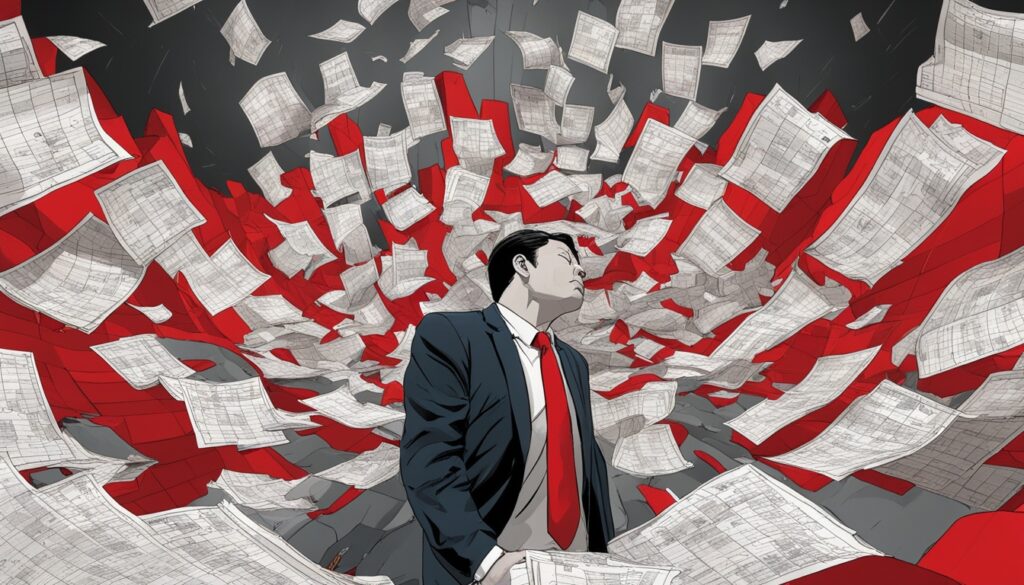Stock Market Crash Crisis: Laughing All the Way Down
The 1929 stock market crash was a major financial disaster. Yet, it also opened doors for smart investors and speculators to make big gains. Jesse Livermore, for example, earned over $100 million by betting against the market. Bankers like Albert H. Wiggin and Charles Edwin Mitchell also made a lot of money, but at others’ expense.
Some, like Bernard Baruch and John Raskob, smartly got out of the market before it crashed. They avoided the worst of the financial disaster. This shows that even in tough times, some people can still come out on top.
During the stock crisis, a few individuals not only survived but thrived. The 1929 market crash and the following recession were chances for those who could see the future. These smart investors made money from others’ losses, laughing all the way to the bank.
Notorious Profiteers of the 1929 Stock Market Crash
The 1929 stock market crash hit the American economy hard. A few people made a lot of money from others’ losses. These profiteers of the 1929 crash took advantage of the chaos to grow their wealth. They did this by taking money from people who didn’t know any better.
Jesse Livermore: The Short-Selling Maverick
Jesse Livermore was a famous short-selling expert. He made over $100 million by predicting the stock market crash 1929. His smart moves and going against the crowd helped him make a lot of money. He became known as the “greatest bear of Wall Street.”
Albert H. Wiggin: The Bankers’ Betrayal
Albert H. Wiggin led Chase National Bank. He did something very wrong. He short-sold his bank’s shares and used a fake company to avoid taxes on his $4 million gain. This left his clients with huge losses.
Charles Edwin Mitchell: The Architect of Financial Ruin
Charles Edwin Mitchell ran National City Bank. He pushed to sell $650 million of his bank’s stock at high prices before the crash. This left many investors with big losses. Mitchell’s actions showed the greed and lack of care for others that was common back then.
| Profiteer | Gain | Tactics |
|---|---|---|
| Jesse Livermore | $100 million | Short-selling maverick |
| Albert H. Wiggin | $4 million | Bankers’ betrayal |
| Charles Edwin Mitchell | $650 million | Architect of financial ruin |
“The stock market is designed to transfer money from the active to the patient.” – Warren Buffett
Theories on Why the Stock Market is Going Down
Many funny theories have popped up to explain why the stock market is down. One idea is that the market is trying to lose weight, like a person on a diet. Another theory says the algorithm that makes trading decisions has a bug, causing bad choices and market trouble.
The Market’s on a Diet
Some think the stock market wants to get fit. It’s like someone trying to lose weight, cutting down on what it holds. This could mean ups and downs in the short term, but it might make the market healthier later.
The Algorithm Got a Cold
Another reason for the market’s drop is the algorithms that guide Wall Street trading. These systems are supposed to make quick investment choices but might be acting strangely. When they’re not working right, they can cause the market to fall, making bad trades.
The Market’s Having a Midlife Crisis
Some believe the stock market is having a midlife crisis. It’s like a person in their 40s or 50s feeling lost and looking for new meaning. This could lead to unpredictable trading and a general feeling of unease, making the market decline.
These theories might be fun, but they show how people try to make sense of the stock market’s ups and downs. As investors deal with the downturn, these ideas offer a break from the seriousness. They remind us that complex financial systems can be seen in simple terms.

Hedge Fund Crowding Hits Record Highs
The hedge fund industry is seeing a huge amount of crowding. Now, the typical hedge fund has 70% of its long portfolio in just its top 10 positions. This level of concentration is the second highest in 22 years, according to Goldman Sachs’ “Hedge Fund Trend Monitor.” The only other time it was this high was in the fourth quarter of 2018.
The third quarter of this year saw the highest level of crowding in the 22-year history. This record high hedge fund crowding means there’s a big risk of sudden and severe market drops.
A basket of the most popular hedge fund positions has jumped by 31% so far this year. This is mainly thanks to the “Magnificent Seven” – Alphabet, Apple, Amazon, Meta Platforms, Microsoft, NVIDIA, and Tesla. These Big Tech names have seen huge gains, making the Momentum factor even more focused on them due to hedge fund crowding.
But, picking stocks has gotten harder, even with the S&P 500 up 20% and the Nasdaq Composite up 37%. Stocks are moving together more and not as differently as before. This makes it tough for active stock picking, with crowded stocks falling more in market downturns.
As the market goes through ups and downs, investors need to be careful. High hedge fund crowding could lead to big swings and losses if the market corrects itself.
Stock market crash crisis: The Quant Factor of Crowdedness
As the stock market prepares for a crash, a key factor could make things worse – crowdedness. This “quant” factor, like Momentum, affects market trends and risks during tough times.
Now, almost 79% of all shares are owned by big investors, up from just a few hundred in the 1980s. This rise has made some stocks very popular with hedge funds, leading to crowding.
A study found that the most crowded stocks can fall much harder than others during a crash. This shows how vital it is to grasp the risks of quant factor crowdedness and stock market crash crowdedness.
| Metric | Value |
|---|---|
| Value-weighted quintile portfolio of most crowded stocks’ monthly alpha | 0.54% |
| Least crowded quintile’s monthly alpha | -0.90% |
| Spread portfolio (high-minus-low) monthly alpha | 1.44% (17.28% annualized) |
| Portfolio long most crowded stocks, short least crowded stocks’ monthly alpha | 1.7% |
The data shows how big the risk of hedge fund crowding is. As the market faces a possible crash, knowing and dealing with crowdedness risks is key for investors and policymakers.

Riding High on the Momentum Factor
The stock market’s ups and downs have made hedge funds turn to the momentum factor. They’re focusing on Big Tech stocks because they’re doing well. This move is a change from 2022, when funds bet against momentum and stuck with tech and growth stocks even when they were down.
This shift has helped hedge fund investors a lot. But, there’s a big risk in following the crowd too closely.
The momentum strategy has a long history, with over 700 trading ideas from thousands of research papers. It’s all about buying stocks that have done well and selling those that haven’t. This approach has made money in stock markets all over the world.
But, it’s not all good news. In 2009, the momentum strategy lost more than 80% of its value. And in the first quarter of 2023, it fell by 4%, which is a big drop.
Even with these ups and downs, the momentum factor still helps long-only portfolios a lot. It’s more profitable when buying stocks than when shorting them. The Quantitative Momentum ETF shows how this strategy works, with a test period from 1927 to 2013 and regular rebalancing.
Hedge funds will likely keep using the momentum factor to make money. But, investors should watch out for the risks of following the crowd too closely. They should think carefully about how much of this strategy they want to use.
“The momentum strategy involves selecting stocks based on returns over a set period (J months) and holding them for another set period (K months).”
A Warning About Crowding and Tail Risk
High levels of crowding have helped hedge funds so far. But, when crowding gets too high, it can lead to big risks. Crowded stocks tend to fall a lot more during market downturns. The most crowded stocks can drop much more than the least owned ones.
Also, being too crowded in positions means higher volatility and deeper losses. This shows investors need to be careful in crowded markets. It’s important for investors to watch out for the dangers of crowding as markets deal with its effects.
Crowded Stocks Fall Harder During Selloffs
The Great Crash of 1929 saw the Dow Jones fall 23% in two days, showing the danger of crowded trades. Over the last century, US equity returns have averaged about 10% a year, showing the market’s strength. But, crowded stocks can drop much more during downturns than less crowded ones.
Increased Volatility and Drawdowns
The more crowded positions get, the more volatile and deeper the losses can be. Even smart people, like finance experts and students, can lose everything from crowded trades. In a risk game, 25% of the players lost all their money.
As markets change, with private markets growing and investment processes getting more complex, managing crowding risks is key. Investors need to understand and handle these risks to navigate the financial world well.
“Crowded trades have a causal effect on the positive tail of the stock return distribution, indicating that crowded stocks can experience larger gains and losses compared to less-crowded stocks.”
Signs of a Deteriorating Stock-Picking Environment
Even though the overall market is doing well, a worrying trend is showing up – the stock-picking environment is getting worse. Goldman Sachs says the top hedge fund positions are doing better than the most shorted ones. This hides the big challenges active investors are facing.
Two main signs show how tough it’s getting to pick stocks well: rising stock correlations and falling return dispersion. These signs mean stocks are moving together more, making it tough for fund managers to spot unique chances.
Rising Stock Correlations
Stocks are moving together more, which means they’re more connected. This makes it hard for investors to tell which stocks are doing well or not. Stocks are more like the market, not just themselves.
Falling Return Dispersion
Return dispersion, which shows how different stocks perform, is going down. This means the top and bottom stocks are performing closer together. It’s harder for active managers to beat the market by picking stocks well.
Goldman Sachs points out the deteriorating stock-picking environment. With rising stock correlations and falling return dispersion, active managers are finding it tough to find the best investments. Investors need to rethink their strategies to keep up with the market’s changes.
Trend Reversal for the “Magnificent Seven”
The “Magnificent Seven” – Alphabet, Apple, Amazon, Meta Platforms, Microsoft, NVIDIA, and Tesla – have seen big changes. These tech giants were key to hedge fund success early in the year. But, their growth slowed down in the third quarter.
Now, hedge funds are increasing their investments in these stocks. This has led to a big change in the fourth quarter. Hedge funds are selling these stocks at a fast pace, showing they might be overconfident.
The magnificent seven companies lost $600 billion in value on one day recently. This shows how unpredictable the market can be. It also points out the risks of hedge fund tech selling and tech stock trend reversal.
“The market’s on a diet, the algorithm got a cold, and the market’s having a midlife crisis.” – Market Analyst
As the market deals with these ups and downs, everyone is watching the “Magnificent Seven”. They will help show where the tech sector and the market are headed.
The tech world is changing fast, and the potential tech stock trend reversal means we need smart investment plans. With market ups and downs ongoing, the “Magnificent Seven” will keep being watched by investors and market experts.
Seeking Alpha in a Poor Stock-Picking Environment
In a tough stock-picking world, investors might look to a contrarian strategy. Goldman Sachs recommends focusing on “controversial” stocks. These are in the top 20% for both hedge fund interest and short interest compared to their size. This mix of high interest and skepticism could reveal hidden gems in the market.
The firm’s list of the top 10 most “controversial stocks” from the third quarter includes names like Lyft, RH, Wayfair, Advance Auto Parts, American Airlines, and Confluent. Investing in these stocks, shunned by many but favored by smart investors, could lead to big gains. This is because the market often misses the mark.
But, investing in controversial stocks is risky. These companies are under a lot of scrutiny and can be very volatile. You need a strong stomach and a deep understanding of their business. Yet, for those ready for the challenge, the chance to find alpha in a tough market could be very rewarding.










Post Comment